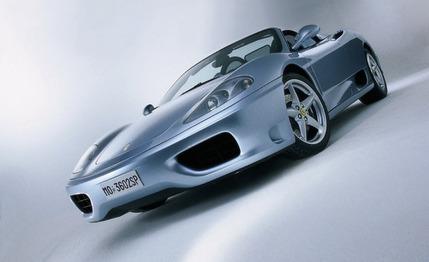
 First Drive Review
First Drive Review
At the introduction of Ferrari's new 360 Spider in Monaco, we were shown an in-car video of one lap of the Grand Prix course as driven by Michael Schumacher in his Formula 1 Ferrari. This tape has telemetry subtitles to help you understand the plot, and we goggled at it in awe as the speed display scrambled to well over 300 kilometers per hour in the tunnel along the edge of the Mediterranean Sea.
That's 186-plus miles an hour in local speed lingo, and it's completely inconceivable to anyone who's ever driven through that tunnel. Later, while at the wheel of the new 360 Spider, we did drive through that curved cavern, and although we didn't quite reach 186 mph, we did get to 8500 rpm, which we think is just as much fun and not nearly as dangerous.
See, the unattenuated sounds coming from the rear of the Spider at those revs are just about worth the $171,000 price of admission. That soundtrack mixes a soft pulsing zing from the valvetrain with the bright, edgy blare from the four exhaust tips and then overlays it with an uninhibited induction howl from a scoop behind the driver's left ear.
With Ferrari North America's new British boss, Stuart Robinson, in the right-hand seat, we accelerated hard through the tunnel and let the cascading sound effects bounce and tumble around us, finally emerging into the sunlight laughing like madmen.
But the Spider is not just about wonderful noises. It's also about driving alfresco while smelling the perfume of Alpine flowers and the mixed aroma of beer and coffee that wafts from bars in small Provencal villages set in from the coast. And because the car is so stiff in structure and well endowed in the engine and suspension departments, it's about high speed, too.
The 360-series was designed from the outset to be supplied in both coupe and convertible forms -- an outcome made somewhat easier by the car's stiff aluminum space frame. Still, any roofectomy requires some structural reinforcements.
By beefing up the car's space frame at the lower longitudinal rails, cowl uprights, and upper longitudinal spars behind the rear bulkhead, Ferrari achieved structural stiffness that is 20 percent better in torsion than in the preceding 355 Spider, and 25 percent better in bending. Because aluminum is used instead of steel tubing, the Spider weighs just 132 pounds more than the 360 coupe.
Leather-wrapped rollover bars integrated into the space frame just behind the passenger compartment work in concert with a beefed-up windshield frame to achieve rollover crash-test results that reportedly equal the coupe's.
During our various adventures in and around Monaco, a little steering-column shiver was the only evidence of the car's decapitation. When you take into account the high levels of road feel and steering feedback already present in the 360, this tiny tremor is pretty much lost in the mix.
Housing the fully powered top was quite a challenge, given the mid-engined layout of the 360-series cars, and Ferrari wisely handed the design and fabrication work off to CDS, a Porsche/Mercedes-Benz cooperative venture that supplies powered tops for both of those brands.
CDS engineers used shared Ferrari CAD data to develop a one-touch mechanism employing eight hydraulic actuators and two electric motors in an articulating aluminum and steel structure.
The top folds double and stows itself under a hard tonneau cover -- complete with stubby fins -- which slides back, lifts off, and then lowers into place during the elaborate 20-second choreography performed by the top mechanism. A screen mounted between and within the roll bars effectively reduces wind buffeting, and the cockpit remains tranquil even at high speed.
When erect, the fabric-top structure flaunts little flying buttresses at both sides of the plastic rear window that cover -- and emulate -- the look of the fins. The top is altogether a fairly seamless device, with a carefully tensioned internal roof liner to hide the framework from occupants.